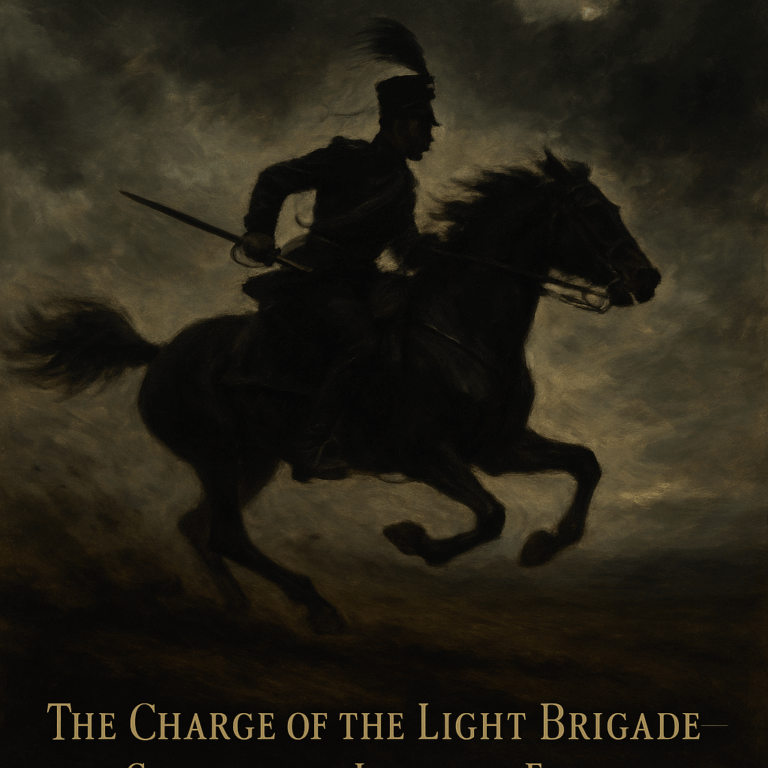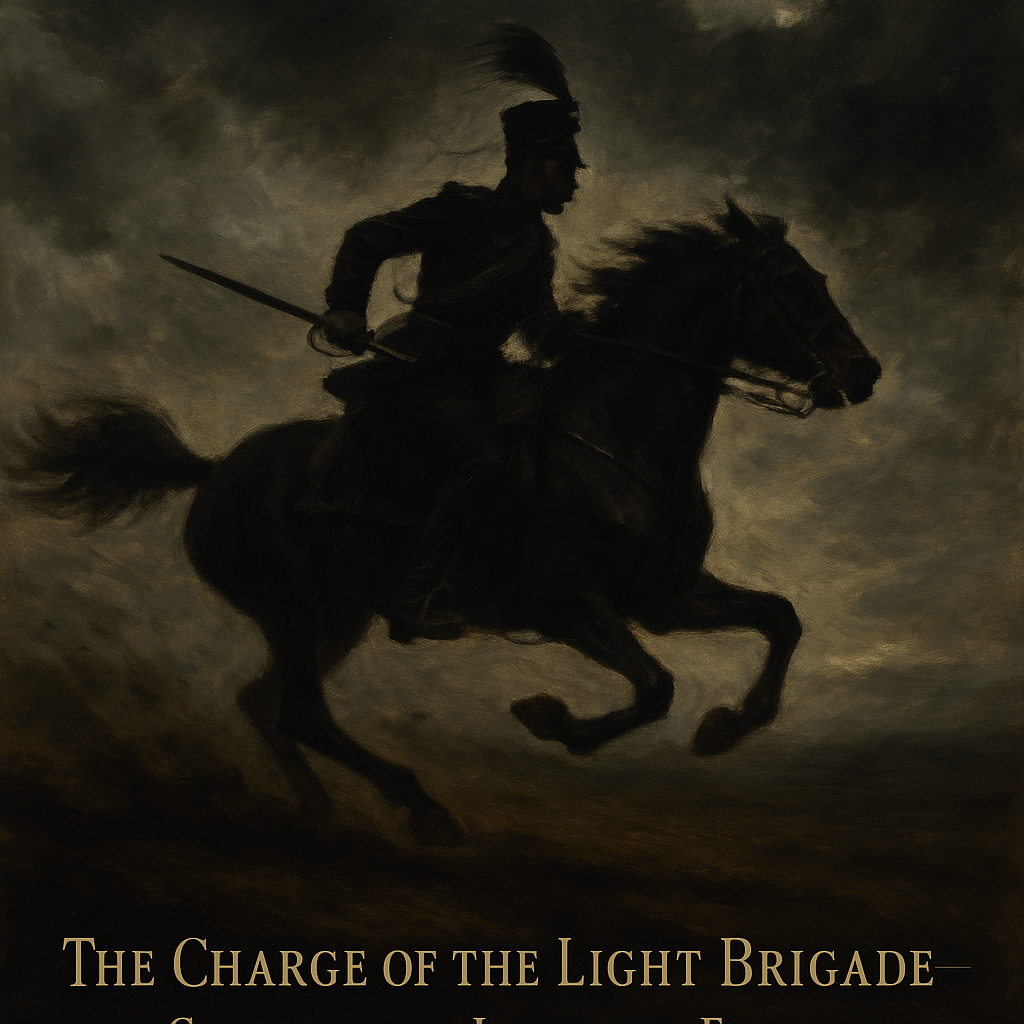The Charge of the Light Brigade: When Futility Galloped into Legend
Once upon a time, in the grand theater of 19th-century European warfare, there was a moment so spectacularly futile it could make a dead horse neigh in exasperation. Enter the Charge of the Light Brigade, an exquisite example of military blunder, political bungling, and sheer stubbornness masquerading as valor. A perfect fit for the phrase “beating a dead horse,” except here the horse was not just dead—it was being sent headlong into a Russian gun battery with the enthusiasm of someone repeatedly tapping on a malfunctioning vending machine, expecting different snacks.
The setting: October 25, 1854, during the Crimean War, a conflict somewhat forgotten by history but immortalized in this particular episode. The British cavalry, led by Lord Cardigan, was ordered to charge into the valley of the River Balaclava. The problem? Due to a series of tangled miscommunications and perhaps a collective bout of selective hearing among the commanders, the Light Brigade charged the wrong artillery battery. Instead of the enemy’s fleeing guns, they galloped directly into the bristling teeth of well-prepared Russian cannons. The cavalrymen essentially volunteered as cannon fodder in a spectacular act of futility.

Miscommunication: The Art of Making the Dead Horse Dance
The phrase “beating a dead horse” fits this blunder like a worn-out boot on a battlefield. The order was vague and the execution more so—a parade of errors that can only be explained by either impressive incompetence or the era’s lack of Starbucks-fueled meetings to clarify orders. The actual command, as relayed by Lord Raglan to Captain Nolan, was to prevent the Russians from removing captured guns; but the vagueness of the delivery meant the Light Brigade charged directly into an entrenched battery instead of supporting the infantry.
Here we have a metaphorical horse that has been beaten not once, but repeatedly, with each messenger compounding the muddle. Captain Nolan himself, who delivered the orders, galloped ahead with the zeal of a man who’d just learned about adrenaline but missed the flyer about “reading orders carefully.” His enthusiastic pointing and shouting nearly qualify as the first recorded instance of what today we might call “enthusiastic mismanagement.”
Lord Cardigan: Hero or Horse-Beater-in-Chief?
Lord Cardigan, who led the charge, was no doubt a fine officer in terms of horse-riding and impressive mustache cultivation, but when it came to strategic thinking, he might as well have been petting the dead horse himself. His decision to obey an obviously flawed order without question puts him solidly in the category of those who beat the dead horse loudly, proudly, and without a hint of self-awareness.
As the Light Brigade blitzed into the valley with the grace of a bull in a china shop, they suffered over 40% casualties—a staggering loss, easily avoidable if the orders had been a smidge clearer and the commanding officers less in love with the idea of a gallant charge. It’s almost as if Cardigan and friends were determined to prove that if you keep hitting that dead horse, eventually it might respond.
Tennyson’s Poem: Glamourizing the Futility
Alfred, Lord Tennyson, famously immortalized this blunder with the poem “The Charge of the Light Brigade,” giving a poetic gloss to what was essentially a desperate and futile blunder. Lines like “Theirs not to reason why, / Theirs but to do and die” capture the blind obedience and tragic heroism of the charge—sound familiar to anyone who’s ever been in a meeting where terrible ideas just keep getting nodded along?
Tennyson’s poem turned the episode into a stirring tale of heroism, even as the reality was more about a disastrously beaten dead horse. It’s as if he tried to dress this military fiasco up in a tutu and call it ballet, diverting attention from the fact that the cavalry’s noble horses had been thoroughly trampled by political folly.
The Aftermath: Horses and Men Both Dead, and the Blame Still Riding High
Despite the clear folly of the charge, attempts were made to *rally* the narrative, much like insisting on whipping that dead horse a few more times after it’s already been carted off for glue. The British public was fed the heroic version, complete with medals and honors, while the real causes—confused commands, poor intelligence, and reckless leadership—were glossed over with patriotic fervor.
The Light Brigade’s futile charge became less about strategy and more about the spectacle of “duty” and “honor” in the face of certain destruction, a deadly serious game of “How Can We Make This Worse?” played out on the clay of the Crimean peninsula.
Soldiers who survived the charge later complained about the meaningless slaughter, expressing frustration that could have been summed up by the phrase “beating a dead horse”—only in their case, the horse was their collective fate.
Cartoons and Satire: Drawing the Dead Horse for All It’s Worth
In the years following the battle, the phrase “beating a dead horse” gained popularity in the English language, often used by political cartoonists and satirists to mock government policies and military decisions. The Charge of the Light Brigade became a kind of poster child for futility, a golden goose for cartoonists who loved nothing more than illustrating a well-meaning but disastrous march into irrelevance.
Charles Keene, an illustrator for the *Punch* magazine, took great joy in caricaturing the leadership involved, depicting generals on horseback blundering headlong into the abyss while their underlings grimly beat the metaphorical dead horse to keep the doomed charge “motivated.” These cartoons were so sharp that they might as well have been written as a polite memo titled: “Hey Guys, This Is a Blunder. Let’s Not Do It Again.”
Political satirists love to use the Light Brigade charge as a stand-in for any campaign that continues long past reason, with the image of a determined rider flogging a horse that’s been six feet under since the last cannon shot. This perfect metaphor illuminates how humans double down on failed efforts—because giving up would be conceding to the obvious.
Lessons from a Horse That Won’t Get Up
If there is one takeaway from the Charge of the Light Brigade, it is this: sometimes no amount of beating, whether it’s on the battlefield or in boardrooms, will bring life to a lost cause. The stubbornness to charge ahead despite overwhelming evidence of disaster is the essence of beating a dead horse, whether literally or metaphorically.
This military blunder reminds us all that being brave is not enough when your orders are nonsense and your leadership has confused “gallantry” with “wastefulness.” It’s an entertaining, if tragic, testament to human folly—one that still echoes in every futile campaign that insists on chasing a lost cause with unyielding enthusiasm.
Tennyson’s enduring phrase “Theirs not to reason why, Theirs but to do and die” reminds us humorously of the danger of obedience without thought. That dead horse might be lying there for a reason, yet the charge continues as if the rumpus flapping its ears still demanded a fight. It is the perfect cautionary tale, or as political satirists would say, the horse that keeps getting whipped long after the cavalry should have dismounted.
So next time you find yourself involved in a futile endeavor, just remember the Light Brigade—the ultimate dead horse beaters—and consider whether charging ahead is really the best idea, or if it’s just a stylish way of meeting history’s great big, ironic facepalm.
